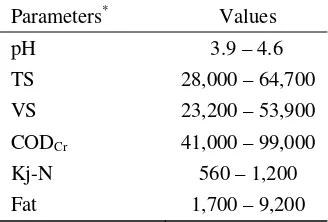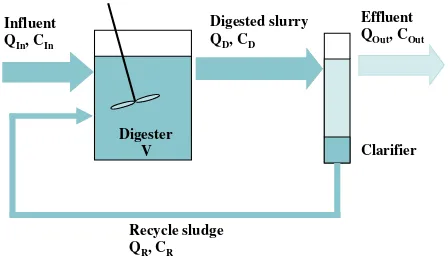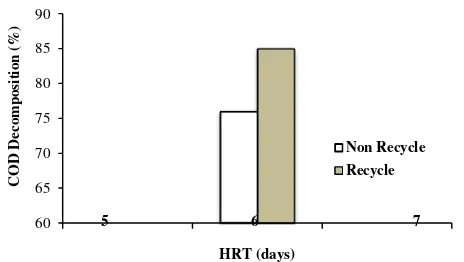Download details:
IP Address: 114.125.17.101
This content was downloaded on 04/07/2017 at 16:33
Please note that terms and conditions apply.
View the table of contents for this issue, or go to the journal homepage for more
Effect of Recycle Sludge on Anaerobic Digestion of Palm Oil
Mill Effluent in A Thermophilic Continuous Digester
Irvan*1,2, B Trisakti1,2, Y Tomiuchi3, U Harahap4and H Daimon5
1Chemical Engineering Department, University of Sumatera Utara, Medan, 20155, Indonesia 2Sustainable Energy and Biomaterial Center of Excellence, University of Sumatera Utara, Medan, 20155, Indonesia
3Metawater Co., Ltd. 7, Yawata-kaigandori, Ichihara-city, Chiba 290-8511, Japan 4Faculty of Pharmacy, University of Sumatera Utara, Medan, 20155, Indonesia
5Department of Environmental and Life Sciences, Toyohashi University of Technology, Toyohashi, 441-8580, Japan
E-mail: [email protected]
Abstract. The objective of this research is to maintain short retention time and high degradation of palm oil mill effluent (POME) to biogas by applying recycle sludge. Fresh POME from Rambutan Mill without further treatment was used as feed. Two lab-scale digesters supported from Metawater Co. Ltd. have been applied to treat POME at thermophilic (55oC) condition. Both digesters were operated under intermittent operation mode. Experiments were performed in two methods: with and without recycle sludge. Hydraulic retention time (HRT) of both methods was maintained at 6 days, while sludge retention time (SRT) was maintained at various days. The result showed that by extending SRT in return sludge process where 25% of digested slurry recycled to the digester, improvement of volatile solid (VS) decomposition was obtained around 84% at HRT of 6 days and SRT of 21 days. Then, chemical oxygen demand (COD) removal efficiency could be reached until 85% by using recycle sludge.
1. Introduction
Palm oil manufacturing is one of Indonesia’s major industries. Approximately 23.5 million tons of crude palm oil (CPO) was produced in 2012 [1]. It makes Indonesia become one of the countries with largest production of CPO, followed by Malaysia. The amount of the palm oil mill effluent (POME) discharged is estimated to be three times CPO production.
The common POME treatment method utilized by palm oil mills is the application of lagoon systems. POME is treated in a series of anaerobic lagoons [2]. This method is an easy operating system but it has disadvantages such as, requires a long retention time of 20 to 200 days [3], the use of large areas (5 hectares for a palm oil mill with a capacity of 30 tons fresh fruit bunches/hour), bad odor and uncontrolled methane emission from the ponds to the atmosphere. In addition, the cost of dredging and handling the sludge from the lagoons is high because sludge accumulates at the bottom of the lagoons. This accumulation reduces the effective volume of the lagoons.
2
requires relatively long hydraulic retention time (HRT) which is 18.75 days. Therefore, it needs high investment cost for the application [4].
Irvan et al in 2012 conducted POME conversion into biogas using anaerobic microbes in a 2 (two) liters continuous stirred tank reactor (CSTR) at temperature of 55 °C (thermophilic), closed systems, intermittent, and HRT variation. They succeeded in converting POME into biogas at HRT 6 days with quantity and quality of biogas similar to the Novaviro’s process, although decomposition of COD was still less than 80%, at HRT 10 days [6]. Therefore, the purpose of this research is to study the effect of recycle sludge in the new methane fermentation system capable of maintaining high speed and high degradation of POME to biogas.
2. Materials and methods
2.1. Characteristics of POME
Fresh POME was collected from a fat pit of palm oil mill’s wastewater treatment facility belongs to Rambutan Palm Oil Mill PTPN III, located at North Sumatera, Indonesia. The collected fresh POME was kept in 10 L clean containers and stored at 4oC in refrigerator for further analysis and use. It was
used as feed in the digester having characteristic shown in Table 1. While, anaerobic digested wastewater taken from anaerobic pond of the same treatment facility was used as inoculum.
Table 1. Characteristics of fresh POME
Parameters* Values
to minimize H2S production, and the addition of NiCl.6H2O and CoCl2.6H2O are required for anaerobic
microbial metabolism.
2.2. Mass Balance of Recycle Sludge
A continuous stirred tank reactor (CSTR) was employed in this study. In complete mix systems, digested slurry is settled in an external clarifier, and the microbe-rich sludge is recycled back to the digester. Mass balance of recycle sludge in the anaerobic digester was analyzed. Schematic drawing of anaerobic digester with recycle sludge is shown in Figure 1. It identifies which variables are associated with the streams, such as: influent volumetric flow rate QIn (L/day), effluent volumetric flow rate QOut (L/day),
sludge recycle volumetric flow rates QR (L/day), digested slurry volumetric flow rates QD (L/day) influent concentrations CIn (gr/L), effluent concentrations COut (gr/L), sludge recycle concentrations CR
Figure 1. Schematic drawing of anaerobic digester with recycle sludge
= (1)
= (2)
2.3. Experimental Method
All experiments were carried out in two transparent jar digesters (EYELA, model MBF 300ME) which each has a total capacity of 2.2 L and a working volume of 2 L. It worked as a well-stirred reactor with a continuous agitation of 250 rpm, and the temperature was maintained at 55 ± 1oC by means of a water jacket. A data logger (KEYENCE, Model NR-250) was connected to computer to enable automatic recording of temperature and pH, provided by censoring equipment attached to digester [7].
Experiments were performed in two methods: with and without recycle sludge. Loading up was carried out based on the increased production of biogas which measured by using a wet gas meter (SHINAGAWA, Model W-NK-0.5B). Hydraulic retention time (HRT) of both methods was maintained at 6 days, while sludge retention time (SRT) was maintained at various days (8 to 22 days). If biogas production raised by 20%, then the loading up was increased by 20% as well, until HRT 6 days was achieved.
Digested slurry was allowed to settle for 6 hours in a 1,000 ml volumetric flask as an external clarifier before 25% of it was recycled to the digester. After that, the recycled sludge was analyzed by chemical oxygen demand (COD), total solid (TS), volatile solid (VS), alkalinity, and pH. Concentrations of H2S and CO2 in the biogas were measured by using a suction gas injector (GASTEC, type GV-100S) and inspection tube (GASTEC, 25 ~ 1600 ppm).
3. Results and discussion
3.1. Biogas Production in Digester
Biogas production depends mainly on operational parameters such as feeding material, pH and temperature. Figure 2 shows the biogas production during the fermentation proses with and without recycle sludge. At a glance if we notice Figure 2, there is no difference between the two graphs. However, in order to achieve HRT 6 days, these two systems are different.
4
Figure 2. Biogas production of anaerobic digester with and without recycle sludge
For fermentation with recycle sludge, HRT 6 days was achieved at day 26, while for the non-recycle sludge was at day 36, which means there is a difference of 10 days to reach HRT 6 days. This could happen because digester with recycle contained the numbers of bacteria more than digester without recycle, due to the return of sludge every day. Furthermore, stable condition in the recycle system was achieved faster than without recycle. Where, fermentation with recycle, biogas began to increase until it reached a stable condition at day 43 and the production of biogas ranged from 7 to 9 L/day, while for the non- recycle fermentation, stable condition was achieved at day 53 and the production of biogas ranged between 8 to 9 L/day. As it is observed in Figure 2, the recycle did not have a significant effect in the biogas generation, since there were not significant differences between the two graphs.
3.2. Effect of Recycle Sludge on Alkalinity and pH
Alkalinity and pH adjustment within the optimum range is very important for effective anaerobic digestion process [8]. Therefore, additional substances are often inserted into the digester which containing insufficient alkalinity. POME used in this study was acidic with pH ranged 3.9 – 4.6. Thus alkalinity and pH adjustment to within the range of 2,000 – 5,000 mg/L [9] and 6.8 – 7.2 [10] for alkalinity and pH range, respectively, was taken into consideration in this experiment. In the feed preparation of this experiment, 2.5 g/l of sodium bicarbonate (NaHCO3) was added to the influent. The
pH in the digester with recycle sludge increased to 7.5 - 7.7 from an initial value of 4.0. While, pH in the digester without recycle sludge increased from 4.0 to 7.7 - 7.5.
Figure 3. Effect of recycle sludge on alkalinity and pH
3.3. Effect of Recycle Sludge on Total Solid
Total solid (TS), as defined by Standard Methods, is the material residue left in a vessel after evaporation of a sample and its subsequent drying in an oven at 103 to 105°C for one hour [11]. Figure 4 shows the profile of TS inside the digester with and without recycle sludge
Figure 4. Effect of recycle sludge on total solid
As shown in Figure 4, in the fermentation with recycle sludge, TS decreased from 30,000 mg/L to at about 20,000 mg/L, then relatively constant at 28,000 – 30,000 mg/L. While, without recycle sludge TS decreased from 30,000 mg/L to at about 20,000 mg/L, then relatively constant at that value. TS in the digester with recycle sludge was higher than without recycle, this is because the sludge recycled to the digester came from the bottom of the clarifier are still containing material with high TS.
3.4. Effect of Recycle Sludge on VS Decomposition
6
Figure 5. Effect of recycle sludge on VS decomposition
As shown in Figure 5, in the fermentation process without recycle sludge at HRT 6 days, VS decomposition had the highest value of 65% and the lowest value of 53%. While in the fermentation process with recycle sludge, due to the increase of SRT then VS decomposition was also increased. At SRT 21 days, VS decomposition reached maximum value at 84 %, while the lowest value of 58% was achieved at SRT 8 days. From the results obtained, it can be confirmed that volatile solids conversion to biogas is a function of SRT.
3.5. Effect of Recycle Sludge on COD Removal
The advantageous effect of the recycle sludge in terms of COD was observed. Figure 6 shows the effect of recycle sludge on COD removal. At HRT 6 days, fermentation of POME to biogas using recycle sludge, COD removal efficiency was 85%, while using non recycle sludge COD removal efficiency was only 76 %. This proves that the recycle sludge can increase the COD removal in anaerobic fermentation process. This was confirmed by previous researchers who have demonstrated that COD removal efficiency in the digester with recycle sludge was lower than that without recycle sludge [13, 14, 15]
Figure 6. Effect of recycle sludge on COD decomposition
4. Conclusion
This study has demonstrated the feasibility of anaerobic digestion of POME with recycle sludge. During the fermentation process with and without recycle sludge, biogas production was relatively similar. Alkalinity and TS in the digester with recycle was higher than digester without recycle sludge. The same thing was also shown by the decomposition of VS and COD removal efficiency.
Acknowledgment
This research was supported by Hibah Penelitian Unggulan Perguruan Tinggi No: 017/SP2H/LT/DRPM/II/2016, date February 17th, 2016.
References
[1] Rifai N, Syaukat Y, Siregar H and Sa’id EG 2014, IOSR J. Econ. Finance4 27-39 [2] King LS and Yu LC 2013, Eur. Int. J. Sci. Tech.2 106-114
[3] Yacob S, Hassan MA, Shirai Y, Wakisaka M and Subash S 2005, Chemosphere59 1575–1581 [4] Ji CM, Eong PP, Ti TB, Seng CE and Ling CK 2013, Renew. Sustainable Energy Rev. 26
727-726
[5] Tong SL and Jaafar AB 2004 Energy Smart14 4-11
[6] Irvan, Trisakti B, Wongistani V and Tomiuchi Y 2012, Int. J. Sci. Eng.3 32-35 [7] Irvan, Trisakti B, Sosanty F and Tomiuchi Y 2016, Asian J. Chem.28 377-380
[8] Olvera JR and Lopez AL 2012 Biogas production from anaerobic treatment of agro-industrial wastewater, Rijeka: Intech
[9] Metcalf and Eddy, Inc. 2003 Wastewater engineering: Treatment and reuse, McGraw-Hill New York
[10] Gerardi MH 2006 Wastewater bacteria, Wiley-Interscience New Jersey
[11] American Public Health Association - APHA 2005 Standard methods for the examination of
water and wastewater 21st edition Washington: Port City Press USA
[12] Burke DA 2001 Dairy Waste Anaerobic Digestion Handbook, Environmental Energy Company Olympia
[13] Lee DY, Ebie Y, Xu KQ, Li YY, and Inamori Y 2010, Bioresour. Technol.101 S42-S47
[14] Busu Z, Sulaiman A, Hassan MA, Shirai Y, Aziz SA, Yacob S and Wakisaka M 2010, Pertanika J. Trop. Agric. Sci.33 27-37
[15] Gnanapragasam G, Senthilkumar M, Arutchelvan V, Sivarajan P and Nagarajan S 2010, World J.




